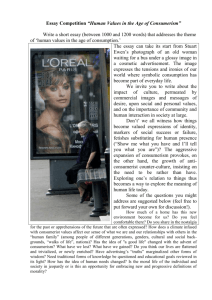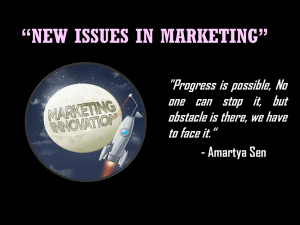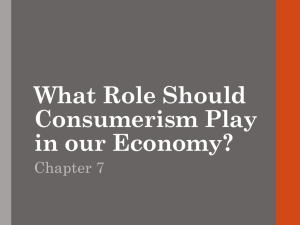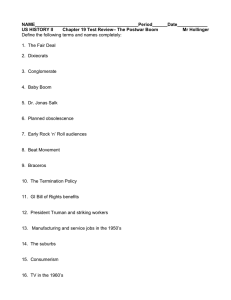The *New Era* & The Lost Generation
advertisement
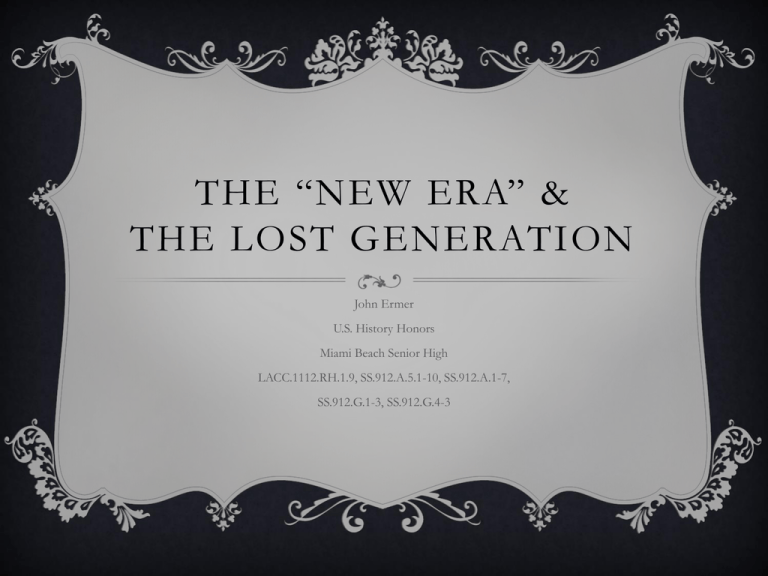
THE “NEW ERA” & THE LOST GENERATION John Ermer U.S. History Honors Miami Beach Senior High LACC.1112.RH.1.9, SS.912.A.5.1-10, SS.912.A.1-7, SS.912.G.1-3, SS.912.G.4-3 NEW CULTURE Faster communication and travel together with rise of consumer culture allow Americans to experience life in increasingly similar ways New values reflect prosperity and complexity of modernity Increasing diversity of American population, culture CONSUMERISM Economic success allows Americans to buy for pleasure, not just need • Refrigerators, washing machines, electric irons, vacuum cleaners • Wrist watches, cigarettes, cosmetics, mass produced fashion/clothing Automobile changes life for urban and rural population • City-dwellers escape congested cities for weekend getaways • Businesses include paid vacations to restore vigor/energy of workers • Isolation of rural life lessened by ease and decreased time of travel • Young people develop social life away from family—youth culture ADVERTISING Rise of advertising industry causes rise in consumerism • Use techniques of wartime propaganda to improve advertising • Identify products with particular lifestyles, investing glamour and prestige • “Buy this product and your life will improve” • Bruce Barton’s The Man Nobody Knows, paints Jesus as super-salesman New forms of communication aid advertising, expand consumerism • Newspaper chains and wire services • New magazines • Saturday Evening Post, Reader’s Digest, and Time MULTIMEDIA Movies increase in popularity and influence, “talkies” debut in 1927 • Al Jolson’s The Jazz Singer is first talkie to create nation-wide excitement Fatty Arbuckle scandal produces calls to “clean up” Hollywood • Motion Picture Association created, Will Hays becomes head of MPA • Hays reviews films for appropriateness, pushes sanctimonious conformity Radio is newest form of communication, available at home • 1920: Pittsburg’s KDKA becomes first commercial radio station • 1927: National Broadcasting Company (NBC) • Radio was more diverse than film, sometimes controversial, but self regulated 1920 S WOMANHOOD Women of the 20s are from multi-generational lines of educated women Professional opportunities remain limited to “feminine work” • Most married women did not work outside the home Behaviorists redefine motherhood as a communal endeavor • Mother’s now less likely to allow children to interfere in married life • Companionate Marriages: women play larger role in husbands’ social lives Increase in birth control devises/methods, Margaret Sanger FLAPPERS & POLITICS Rejection of Victorian ideals of womanly “respectability” • Women smoke, drink, dance, wear seductive clothes/make-up, and “party” New models of womanly independence known as “flappers” • Characterized by certain modes of dress, speech, behavior National Woman’s Party fights for Equal Rights Amendment • Sheppard-Towner Act provides federal funds for prenatal and child health • Terminated in 1929 over concerns of American Medical Association EDUCATION & YOUTH Emphasis on expertise and training raises public school enrollment • College enrollment increases threefold, include modern technical skills • Idea of adolescence as distinct period of development as result of longer periods of training and education and Freudian psychology College becomes place for adolescents to participate in organized clubs and athletics as well as develop own social patterns and hobbies • Primary association with peer groups rather than families THE LOST GENERATION Many youths see WWI as a useless conflict, disenchanted • Rejection of consumerism and U.S. itself • Artists and intellectuals reject “business as usual” of 1920s • Ernest Hemingway’s A Farwell to Arms • F. Scott Fitzgerald’s The Great Gatsby Lost Generation writers criticize many American values, including: religion, democracy, material success, the medical profession, Republican politics, the modern city, the small town THE HARLEM RENAISSANCE African-American neighborhood of Harlem in NYC becomes symbol of flourishing African-American cultural nationwide African-American music gains a white audience African-American writers show pride in their racial heritage • Langston Hughes, Zora Neale Hurston, Countee Cullen “I am a Negro—and beautiful”~ Langston Hughes
